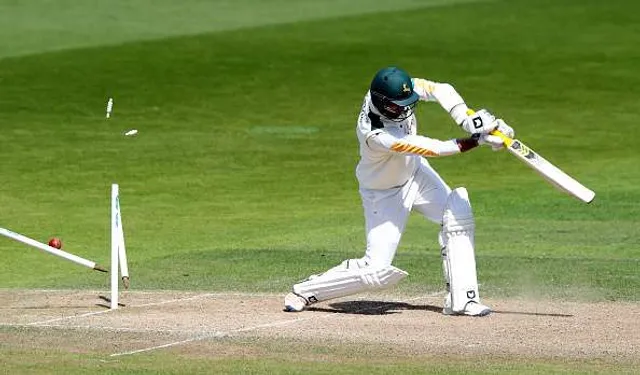From Bowled to Run Out: The 10 Ways a Batter Can Be Dismissed in Cricket
Every ball in cricket holds potential. It could be a boundary, a dot ball—or a dismissal. For players and fans,...

Every ball in cricket holds potential. It could be a boundary, a dot ball—or a dismissal. For players and fans, knowing how many outs in cricket exist is essential to fully understand the game. There are exactly 10 official types of outs in cricket, and each one has its own rules, scenarios, and drama.
In this guide, we’ll break down all ten ways a batter can be dismissed—starting from the classic bowled to the thrilling run out. Whether you’re new to the sport or brushing up on your knowledge, this post will make it clear, engaging, and memorable.
Why Do Dismissals Matter?
Dismissals turn games around. They create momentum, bring crowds to life, and force captains to think fast. Knowing the 10 ways a batter can be out in cricket helps you follow the game more closely and enjoy every moment.
And with cricket being played in over 100 countries, it’s important to grasp how the rules apply universally—whether it’s a backyard match or a T20 World Cup final.
1. Bowled
This is the purest form of dismissal.
What is it?
A batter is out if the ball hits the stumps and the bails fall off.
Key Notes:
- It doesn’t matter if the ball touched the bat or pad first.
- As long as it hits the stumps directly, it’s bowled.
Example:
A yorker sneaks under the bat and hits the base of off stump. The bails fly, and the batter walks. Bowled—simple and powerful.
2. Caught
The most frequent way a batter gets out in professional cricket.
What is it?
If a batter hits the ball with their bat or glove, and it’s caught on the full by any fielder, it’s out.
Facts:
- Over 50% of outs in international matches are caught.
- Wicketkeepers and slip fielders often get the most catches.
Example:
A mistimed lofted shot goes high, and a fielder at long-on settles under it. Clean catch, and the batter is gone.
Try Our Free : DLS Calculator
3. LBW (Leg Before Wicket)
One of the more technical dismissals, but very common.
What is it?
If the ball hits the batter’s leg (or any part of the body), and the umpire believes it would have hit the stumps, it’s LBW.
Conditions:
- The ball must not pitch outside leg stump.
- It must hit the batter in line with the stumps (or outside off if no shot is played).
Example:
A spinner bowls a straighter one. The batter misses, the ball hits the front pad. After an appeal, the umpire lifts the finger. LBW!
Get your Red Leather Ball now.
4. Run Out
High-pressure, action-packed, and often heartbreaking.
What is it?
If a fielder breaks the stumps while the batter is outside the crease during a run attempt, the batter is run out.
Triggers:
- Miscommunication between batters
- Brilliant fielding or direct throws
Example:
The batters go for a risky single. The fielder throws quickly to the keeper who hits the stumps. Replays show the bat is short—run out.
5. Stumped
Timing is everything—especially for the keeper.
What is it?
If the batter steps out of their crease, misses the ball, and the wicketkeeper breaks the stumps before the batter returns—it’s a stumping.
Usually Happens When:
- Facing spinners
- Batters advance to play big shots
Example:
The batter tries to smash a leg-spinner but misses. The keeper is sharp and knocks the bails off. Out—stumped!
6. Hit Wicket
Accidental but very real.
What is it?
If the batter knocks the stumps with their bat, helmet, or body while playing a shot or taking off for a run, they’re hit wicket.
Causes:
- Losing balance
- Swiveling awkwardly on big shots
Example:
A batter tries a pull shot and loses footing. The heel clips the stumps. Bails fall. Hit wicket—out of nowhere.
7. Obstructing the Field
Rare and controversial at times.
What is it?
If a batter intentionally interferes with a fielder’s attempt to play the ball, they are out obstructing the field.
Examples of Interference:
- Using bat or body to block the ball
- Verbally distracting a fielder
Example:
A batter kicks the ball away from the stumps without fielder consent. Fielding team appeals. The umpire agrees—obstructing the field.
8. Timed Out
You snooze, you lose.
What is it?
If a new batter doesn’t take strike within 3 minutes of the last dismissal, they’re timed out.
Important:
- Applies only to incoming batter
- Very rare in modern cricket
Example:
The next batter isn’t ready, taking too long to reach the crease. Fielding team appeals. Umpire rules them out—timed out.
9. Retired Out
Intentional withdrawal = out.
What is it?
If a batter leaves the field of play without approval and doesn’t return to continue the innings, they’re retired out.
Often Happens In:
- Practice or friendly games
- Strategic experiments
Example:
A batter walks off mid-innings without being injured and doesn’t return. Scorecard shows: Retired out.
10. Hit the Ball Twice
Unusual, but it’s in the rulebook.
What is it?
If a batter hits the ball twice intentionally (except to stop it from hitting the stumps), they’re out.
Note:
- The second hit must be deliberate
- Self-defense doesn’t count
Example:
After hitting the ball, it rolls toward the stumps. The batter swipes it again unnecessarily. Fielding side appeals. Out—hit the ball twice.
Quick Overview: All 10 Dismissals
Here’s a fast breakdown for easy recall:
- Bowled – Ball hits the stumps
- Caught – Ball caught before touching the ground
- LBW – Ball hits leg and would’ve hit stumps
- Run Out – Out of crease when stumps are broken
- Stumped – Keeper removes bails with batter out of crease
- Hit Wicket – Batter hits stumps themselves
- Obstructing the Field – Batter blocks fielder intentionally
- Timed Out – Batter not ready in 3 minutes
- Retired Out – Leaves the field without injury and doesn’t return
- Hit Ball Twice – Deliberate second hit
What’s the Most Common Way to Get Out?
Caught. It’s the most frequent and can occur in every format of the game. In fact, over half of all dismissals in ODI and T20 matches are catches.
What’s the Rarest Type of Out?
“Timed Out” and “Hit the Ball Twice” are among the rarest. Together, they’ve occurred fewer than 15 times in over 100 years of international cricket.
How Many Outs in Cricket Are There?
There are 10 officially recognized ways for a batter to be dismissed in cricket, as per the MCC laws.
These rules apply across formats—Test, ODI, T20—and are used in every country where the sport is played.
FAQs
What are the 10 types of outs in cricket?
The 10 are: Bowled, Caught, LBW, Run Out, Stumped, Hit Wicket, Obstructing the Field, Timed Out, Retired Out, and Hit the Ball Twice.
Who decides if a batter is out?
The on-field umpire, and in some cases, the third umpire (TV replay) confirms close calls.
Where does stumping happen?
Only at the striker’s end and by the wicketkeeper when the batter is out of their crease.
Why is ‘Retired Out’ different from ‘Retired Hurt’?
‘Retired Out’ is deliberate and counts as a dismissal. ‘Retired Hurt’ is due to injury and the player can return later.
How do fielding teams appeal for an out?
They shout “How’s That?” or “Howzat” to signal the umpire to make a decision.
Final Thoughts
From bowled to run out, every dismissal in cricket brings its own thrill. Whether it’s a sneaky spinner stumping a batter or a rocket throw running someone out by inches, these moments define matches.
Knowing how many outs in cricket there are gives you a smarter, sharper lens to watch the game. Each dismissal has a story—some quick, some shocking, some downright legendary.
So next time you watch a game, keep an eye on the field. You’ll see strategy, skill, and sometimes, a surprise out of nowhere.






